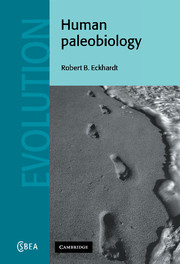Book contents
- Frontmatter
- Contents
- Preface
- Acknowledgments
- 1 Paleobiology: present perspectives on the past
- 2 Constancy and change: taxonomic uncertainty in a probabilistic world
- 3 A century of fossils
- 4 About a century of theory
- 5 Human adaptability present and past
- 6 Primate patterns of diversity and adaptation
- 7 Hominid phylogeny: morphological and molecular measures of diversity
- 8 Plio-Pleistocene hominids: the paleobiology of fragmented populations
- 9 Character state velocity in the emergence of more advanced hominids
- 10 The paleobiology of widely dispersed hominids
- 11 Paleobiological perspectives on modern human origins
- 12 A future for the past
- Bibliography
- Index
1 - Paleobiology: present perspectives on the past
Published online by Cambridge University Press: 18 December 2009
- Frontmatter
- Contents
- Preface
- Acknowledgments
- 1 Paleobiology: present perspectives on the past
- 2 Constancy and change: taxonomic uncertainty in a probabilistic world
- 3 A century of fossils
- 4 About a century of theory
- 5 Human adaptability present and past
- 6 Primate patterns of diversity and adaptation
- 7 Hominid phylogeny: morphological and molecular measures of diversity
- 8 Plio-Pleistocene hominids: the paleobiology of fragmented populations
- 9 Character state velocity in the emergence of more advanced hominids
- 10 The paleobiology of widely dispersed hominids
- 11 Paleobiological perspectives on modern human origins
- 12 A future for the past
- Bibliography
- Index
Summary
Paleobiology has been referred to variously as a science, a discipline, and a paradigm. These terms all sound rather dauntingly formal for what might be characterized more modestly as an attitude toward the past. Logically, paleobiology is a subdivision of paleontology, since it derives its most direct evidence from the fossil record. But although paleontological evidence is itself static, comprising fossilized skeletal parts and associated remains for the most part, the paleobiological approach to this evidence is dynamic. Paleobiologists endeavor to reconstruct credible impressions of past populations and their members as they were in life: feeding; mating; giving birth to offspring and caring for them; avoiding predators; and enduring vagaries of weather, parasites, and diseases. The author of one paleobiological study covering an extinct group of tetrapods commonly referred to as ‘mammal-like reptiles’ noted that her aim was ‘to present the “hard facts” about dicynodonts and then go on to interpret these facts in physiological, behavioural and ecological terms…’ thereby ‘turning mere piles of bones into entities more approaching living animals’ (King, 1990).
Reviewing King's work, Rowe (1991) remarked that paleobiology is no longer the central paradigm that it had been in the 1960s and 1970s; instead other issues, particularly the reconstruction of phylogenies and the related question of evolutionary rates, have replaced paleobiology at the forefront of paleontological research and debate. Perhaps. Nonetheless, paleontological monographs dealing with fossil hominid remains continue to appear (e.g. Trinkaus, 1983; Rightmire, 1990; Madre-Dupouy, 1992; Höpfel, Platzer & Spindler, 1998) and many of these include valuable data that are pertinent to paleobiological reconstructions (Tobias, 1967, 1991).
- Type
- Chapter
- Information
- Human Paleobiology , pp. 1 - 16Publisher: Cambridge University PressPrint publication year: 2000



